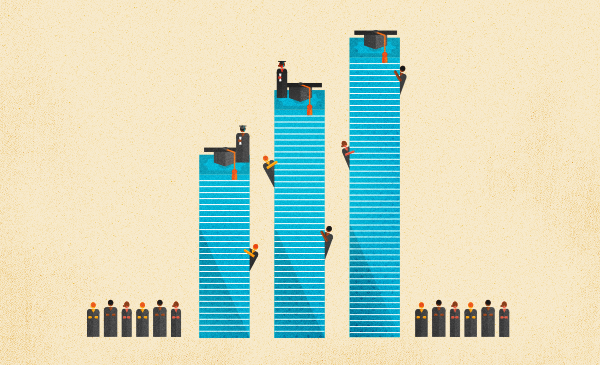A Brief History of Student Debt in the United States
August 22This is the second entry in a three-article series by Kimberly Green about the steady rise of student debt levels across the country. Her first article examined the dynamic between reduced state spending, higher tuition rates, and increased student debt levels; the third and final entry in the series will look at some of potential effects of the student debt crisis.
For the past two decades, student debt has risen each year. In the last eight years, the number has tripled, culminating in today’s shockingly all-time high: according to FinAid.org publisher Mark Kantrowitz, the class of 2013 incurred an average of $30,000 in student loan debt.
Although debt has long been a problem for American students, it has only recently spiraled to this unmanageable level. So what’s going on? This article will provide a historical overview of student debt in the United States.
HISTORY OF STUDENT LOANS

The first student loans in the U.S. were offered exclusively to students at Harvard University in 1840; public student loans did not arise until the 20th century. In fact, the U.S. Department of Education (DOE), which was founded in 1867, did not administer federal student loans until the passage of Title IV of the Higher Education Act in 1965 (HEA).
In the two decades prior to the institution of federally-guaranteed student loans, the U.S. experienced a significant increase in college attendance, however, thanks in part to the passage of the GI Bill in 1944. Fulfilling the need for affordable higher education, the GI Bill subsidized or completely covered the cost of college education for nearly half of America’s returning World War II veterans. Since its inception, this program has remained popular over the years; nearly 32% of all male veterans have used it to attend college as of 2009.
One year after the HEA was enacted, the precursor to the National Association of Student Financial Aid Administrators (NASFAA) was established. Today, this organization enlists more than 18,000 professionals at colleges and universities across the country to help students access higher education through financial aid.
In 1972, the HEA was amended to ensure education programs whose students were receiving financial assistance and student loans did not discriminate based on gender. By 1976-77, all undergraduate students became eligible for Pell grants. Together, these two popular programs further increased college attendance rates by providing financial assistance to individuals who previously could not obtain it.
However, not all student financial assistance has been beneficial. Signs of trouble with student borrowing began to appear by the late 1980s. In 1986, parents and students had incurred nearly $10 billion in federal student loans – then considered an outrageous amount. That same year, more than one quarter of student borrowers owed more than $10,000 in student loan debt; adjusting for inflation, this is equivalent to over $21,000 today.
Certainly by the 1990s, student loan debt began to skyrocket. In 1993, the average debt of a bachelor’s degree graduate was approximately $9,000; five years later, it was about $15,000. By 2003, it had jumped to approximately $17,500.
Today, the average outstanding student loan balance per debtor is roughly $30,000, though one recent study by Fidelity Investments put the figure as high as $35,200. Approximately 20% of U.S. households currently owe student loan debt, as do 40% of people younger than 35. This means an increase of nearly 200% of overall student loan debt (public and private) over the last 20 years. As of 2012, total student debtsurpassed $1 trillion.
CONTEMPORARY TRENDS
There is no single reason why student loan debt has gotten so out of hand. Increased tuition costs, reduced state spending, borrower behaviors, and even choice of major all play a role.
First, tuition rates skyrocketed in recent years. From 1999-2009, average tuition at public four-year colleges increased 73%, and in many states, tuition has continued to sharply rise. One reason for this is that state governments have spent, on average, 28% less on higher ed since the recession began in 2008.
Logically, as state spending decreases, it has to be made up — and student borrowing has historically helped compensate for the shortfall; in 1987, students only paid about 23% of the cost to fund higher education, but by 2012 their share had increased to over 45%. Since federal loans will not cover the increased costs, many students are turning to private loans.
Another factor is the nation’s more relaxed attitude toward borrowing in recent times. It is important to note that students 20 years ago were stricter in their borrowing and graduated with a median debt burden (monthly loan payment as a percentage of monthly income) of only 3.3%. By 2003, the median debt burden of nearly 90% of borrowers hovered around 8%. Prior to 1992, only those students who demonstrated financial need could participate in the federal student loan program; after 1992, many requirements for borrowing from Uncle Sam were relaxed.
There are several other interesting trends that have come to light in recent years, although they don’t lend themselves to simple conclusions. One is that students in the Northeast and Midwest tend to have much higher debt loads when compared with their fellow students in the West. One theory to explain this is the significantly higher concentration of students attending private colleges in the Northeast and Midwest. However, since many private nonprofit colleges actually have a lower “net price” (cost of attendance after grants and scholarships are awarded) than public schools, borrowers may actually need to take out fewer student loans than those who attend public institutions.
Another trend to watch is that graduates with liberal arts degrees suffer higher debt burdens. According to a recent report in the Wall Street Journal, the median debt load for graduates of design, music, and art schools in 2010-2011 was $21,576, while the median debt load of graduates from liberal arts schools was $19,445. In comparison, median debt load for students who graduated from research universities was $18,100 during the same academic year.
Sadly, graduates with these degrees often have the most difficulty paying back their loans. In a recent study by Georgetown University’s Center on Education and the Workforce, those who graduated with degrees in photography and the fine arts suffered unemployment in the range of 10.1%-11.49%, while others with liberal arts degrees, such as anthropology, English and foreign languages had unemployment rates between 8.1%-12.6%. Likewise, employed individuals with degrees in the liberal arts who have jobs still experience the lowest wages, generally speaking.
THE FUTURE OF STUDENT DEBT
This silver lining in all this is that policymakers, college administrators, borrowers, parents, students, and prospective college enrollees are at least aware of the problem, and many are proposing solutions.
One popular route is to eschew the traditional four-year college in favor of a vocational certificate program. In 2012, manufacturers reported that as many as 600,000 jobs went unfilled because workers lacked vocational skills. In fact, a recent report noted there are 29 million jobs in the U.S. that require vocational skills but not a bachelor’s degree, and most award an annual salary of $35,000 or more.
Some solutions look to change the terms of the loans themselves. In addition to locking in low interest rates on federal student loans, some lawmakers are seeking to add provisions such as debt forgiveness for those who have made payments for a period of time, as well as suspension of interest accrual during times of high unemployment.
Another idea, put forward by Senator Kirsten Gillibrand (D-N.Y.), would allow borrowers with student loan debt to refinance at a lower, fixed interest rate, in the same way people refinance their mortgages. Resulting in a savings of an estimated $14.5 billion for borrowers in the first year alone. Sounds like a no-brainer, right?
Wrong. Many don’t realize that Wall Street (and thus, lots of people with a 401k) invests in student debt to the tune of $291 billion. Additionally, the Department of Education owns another $600 billion in loan debt; experts predict the DOE will generate a profit of $51 billion from these funds in 2013. With so many powerful interests standing to lose by transferring this money back to borrowers, it’s unlikely that a bill like Senator Gillibrand’s – which has no co-sponsors – will pass.
No one has a clear idea of what the future holds for education borrowers, but all agree that solutions are needed to ameliorate the student debt crisis. With ever more experts forecasting a burst of the student debt bubble, perhaps lenders and investors will have some incentive to work proactively with borrowers to make student loan repayment easier. In any event, until we act, our young people will continue to face more and more debt on an annual basis.
– Original article posted here




